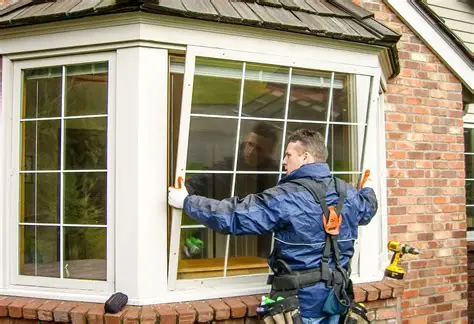Comprehensive Guide to Repairing Windows Affected by Condensation
Waking up to windows streaked with moisture is a familiar sight for many homeowners, painting a hazy filter over the morning view. This common occurrence immediately raises a question: is this a harmless, temporary effect of the weather, or is it a symptom of a deeper, more costly problem with the window itself? It's a moment that can cause immediate concern, prompting homeowners to prematurely search for emergency window repair specialists. The truth is, the answer lies in a simple observation: the location of the moisture. Whether the water droplets are on the interior surface you can touch, the inaccessible exterior pane, or trapped between the layers of glass determines the severity of the issue.
This guide will help you decipher these clues. By understanding why and where condensation forms, you can accurately diagnose the health of your windows, save yourself from unnecessary worry, and confidently choose the right course of action to protect your home’s value and comfort.

The Science of Sweat: Why Windows Form Condensation
At its core, condensation is a simple display of physics. It occurs when warm, humid air comes into contact with a surface that is cooler than its dew point—the temperature at which air becomes saturated and water vapor turns back into liquid. Think of an icy glass of lemonade on a warm summer afternoon; moisture from the surrounding air collects on its cold surface. The same principle applies to your windows, where this phenomenon can manifest in three distinct ways:
● Interior Condensation: Appears on the inside of the glass when humid indoor air is chilled by the cold outside.
● Exterior Condensation: Forms on the outside on warm, humid mornings and is often a sign that your windows are insulating well.
● Inter-Pane Condensation: The most problematic type, where moisture gets trapped between the glass panes of a double- or triple-glazed window.
This third type of condensation signals a broken seal that cannot be simply wiped away and requires a professional solution to address the window's failure.
Managing the Moisture: Addressing Interior Condensation
If the condensation in your home is on the interior surface of the glass—the side you can wipe away with your finger—you can likely breathe a sigh of relief. This type of moisture is rarely a sign of a broken window. Instead, it’s an indication that the humidity level inside your home is too high. Everyday activities like cooking pasta, taking hot showers, running the dishwasher, and even breathing contribute moisture to the indoor air. When this warm, damp air hits the cooler surface of the windowpane, it condenses. The solution, therefore, lies in managing your home’s
atmosphere. Start by consistently using kitchen and bathroom exhaust fans to vent moisture outside. On dry days, cracking a window open for even 15 minutes can significantly improve air circulation. In persistently damp areas like basements, a dehumidifier can make a world of difference. By controlling the source, you can often resolve interior condensation without ever needing to touch the window itself.
The Telltale Fog: When the Seal is Broken
When you see moisture trapped between the panes of a double-glazed window, you are witnessing a completely different and more serious issue. This is a clear sign of a failed seal. Modern windows, or Insulated Glass Units (IGUs), are built with two or more panes of glass separated by a spacer bar and hermetically sealed. This sealed air gap, often filled with an inert gas like argon, is what provides insulation. Inside the spacer is a desiccant material designed to absorb any residual moisture trapped during manufacturing. Over years of exposure to sun and temperature swings, the seal can degrade and break. Once breached, moist air from the outside continuously infiltrates the space between the panes, overwhelming the desiccant. This trapped moisture creates a permanent, frustrating haze that no amount of cleaning can remove, making professional foggy window repair the necessary next step to restore both the view and the window’s insulating properties.
The Crossroads of Decision: Repairing or Replacing Foggy Windows
Once you've confirmed a broken seal, you face a critical choice: repair or replace? Some companies offer a repair service known as “defogging,” where small holes are drilled into the glass to clean and dry the interior, after which tiny vents are installed.
While less expensive upfront, this is largely a cosmetic fix. It does not replace the lost insulating gas, and the new vents can be visible, offering a potential new entry point for moisture down the road. The more permanent and effective solution is replacement.
This can mean replacing just the Insulated Glass Unit (IGU) itself, fitting a new, perfectly sealed glass unit into your existing window frame. This is a great option if your frames are in excellent condition. However, for aging windows where the frame itself may also be compromised, the most durable and energy-efficient solution is a full upgrade. For this level of windows replacement contractors often confirm it is the wisest long-term investment in your home's value.
Clarity Restored: Making the Right Choice for Your Home
The battle against window condensation is won with knowledge. By simply identifying where the moisture forms, you can shift from a state of worry to one of empowered action. This breaks down into two clear paths of action based on where you see the moisture:
● If condensation is on the inside, the solution involves improving household ventilation by running exhaust fans, using a dehumidifier, or opening windows briefly.
● If condensation is between the glass panes, it indicates a broken seal, and the best course of action is to consult a professional for a repair or replacement.
Armed with this understanding, you are now equipped to make the right call. You can confidently determine whether the solution is a simple home adjustment or if it's time to seek expert help, ensuring your home remains comfortable, efficient, and filled with clear, unobstructed views for years to come.
-
The Ultimate Last Minute Stocking Stuffer List
If we forgot about stockings until the last minute, welcome to the club. The stockings are still sitting there, judging us quietly, like tiny fabric to do lists. The good news is last minute stocking stuffers are the easiest part of holiday shopping. They are small, affordable, and weirdly satisfying once the pile starts growing….
-
Last Minute Beauty Gifts That Wow At Kohl’s
Need last minute beauty gifts that still feel thoughtful and expensive? Same. The good news is Kohl’s has the kind of beauty deals that look like we planned ahead. These sets are easy to wrap, feel luxe, and actually get used. Plus, the sale prices are doing most of the heavy lifting for us. Sol…
-
General Mills Game Day Rebate: Spend $30, get $10 back for playoff snacks
The General Mills game day rebate is basically a small miracle for anyone feeding hungry humans during playoff season. We can stock up on easy crowd pleasers and get a little cash back for our trouble. Even better, this offer is built for real life. Whether we are hosting a whole crew or just feeding…
-
Why Prezzee Is the Ultimate Personalized Gift Experience
The Prezzee gift experience goes beyond gift cards. Personalize every gift, add fun AI experiences, and create moments that truly connect people.
-
Shiatsu Foot Massager Deal at Walmart, Save $46 on Relaxation
The Renpho shiatsu foot massager deal is the kind of gift that feels thoughtful without being complicated. It is cozy. It is practical. And it is basically a little “we survived the holidays” trophy for anyone who stands all day, chases kids, or just wants their feet to stop yelling at them. Walmart deal: Renpho…
-
Save $80 on This Countertop Ice Maker at Walmart, Arrives Before Christmas
A countertop ice maker deal is the quiet hero of holiday hosting. Nobody plans for the ice situation. Then suddenly everyone needs ice. This little machine fixes that problem fast, and it is giftable too. Walmart shows it can arrive before Christmas, so it is a legit last minute win. Walmart deal: Simzlife Countertop Ice…







